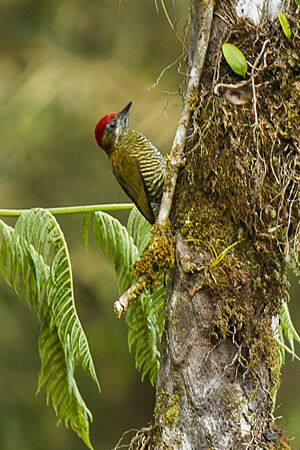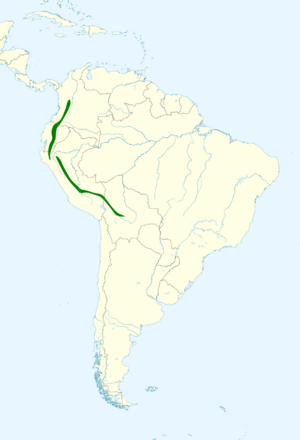Bar-bellied woodpecker facts for kids
Quick facts for kids Bar-bellied woodpecker |
|
|---|---|
 |
|
| Conservation status | |
| Scientific classification | |
| Genus: |
Veniliornis
|
| Species: |
nigriceps
|
 |
|
| Synonyms | |
|
Dryobates nigriceps |
|
The bar-bellied woodpecker (Veniliornis nigriceps) is a cool type of bird that belongs to the woodpecker family. You can find these birds in South American countries like Bolivia, Colombia, Ecuador, and Peru. They are known for their unique look, especially the stripes on their bellies!
Contents
About This Woodpecker's Family Tree
Scientists like to organize living things into groups. The bar-bellied woodpecker is usually placed in a bird group called Veniliornis. This is how the International Ornithological Committee and BirdLife International see it.
However, some other bird experts, like the American Ornithological Society, decided to move all Veniliornis woodpeckers into a different group called Dryobates. It's like different libraries organizing their books in slightly different ways!
There are three main types, or subspecies, of the bar-bellied woodpecker:
- nigriceps (the original type, discovered by Alcide d'Orbigny in 1840)
- equifasciatus (discovered by Chapman in 1912)
- pectoralis (discovered by Berlepsch and Stolzmann in 1902)
What Does the Bar-Bellied Woodpecker Look Like?
This woodpecker is about 17 to 20 cm (6.7 to 7.9 in) long. That's about the length of a regular pencil! It weighs around 39 to 46 g (1.4 to 1.6 oz), which is similar to a small candy bar.
Males and females look very similar, except for the colors on their heads.
- Both sexes have a dark olive-brown face with thin white stripes near their eyes.
- Male woodpeckers have a bright red cap from their forehead to the back of their neck.
- Female woodpeckers have a black cap with a golden color on the back of their neck.
Their backs are dark olive with a bronze shine. Their wings are olive-brown with bronze tips. Their tail is dark, with lighter stripes on the outer feathers. Their bellies are whitish with an olive tint and wide, dark olive stripes. This is where they get their "bar-bellied" name! Their eyes are deep red or brown, and their beaks are gray. Their legs are gray or olive-gray.
Young woodpeckers look a bit duller and greener than adults. They also have more stripes on their tails. Both young males and females have some red on their heads, but the young males have more.
Differences in Subspecies
- The equifasciatus subspecies has light and dark stripes on its belly that are about the same width. The female of this type has a blackish cap with an olive tint.
- The pectoralis subspecies looks a lot like the original type but has slightly darker bellies with very thin light stripes.
Where Do Bar-Bellied Woodpeckers Live?
These woodpeckers live in the Andes Mountains in South America.
- The equifasciatus subspecies lives in the northern parts, from central Colombia through Ecuador and into northern Peru.
- The pectoralis subspecies lives on the eastern side of the Peruvian Andes.
- The original nigriceps subspecies lives on the eastern side of the Andes, from Peru down to central Bolivia.
They like to live in wet mountain forests. You can often find them in "elfin forests," which are forests with small, twisted trees. They especially like areas with lots of thick plants, like Chusquea bamboo. They usually live at high elevations, mostly between 2,600 and 3,600 m (8,500 and 11,800 ft) (about 8,500 to 11,800 feet). Sometimes, they can be found as low as 2,000 m (6,600 ft) (6,500 feet) or as high as 4,000 m (13,000 ft) (13,000 feet) in Ecuador.
How Do Bar-Bellied Woodpeckers Behave?
Staying in One Place
Bar-bellied woodpeckers don't usually move around much. They stay in the same area all year long. They don't travel to different elevations during different seasons.
What Do They Eat?
These woodpeckers look for food at all levels of the forest, from the ground up to the treetops. They spend a lot of time in thick bushes. They usually forage alone, but sometimes you might see them in pairs. They also often join groups of different bird species that are looking for food together.
They peck and flake off bark from trees. They also poke around in patches of moss to find food. We don't know exactly what they eat, but most woodpeckers eat insects and larvae found under bark.
When Do They Have Babies?
Bar-bellied woodpeckers have their breeding season at different times depending on where they live:
- In Ecuador, they breed in February and March.
- In Bolivia, they breed in April and May.
- In Peru, their breeding season includes August.
Scientists don't know much more about how they raise their young.
What Do They Sound Like?
The bar-bellied woodpecker doesn't sing very often. When it does, it makes high-pitched "kee" notes that rise and then drop. It also makes soft "chik" sounds and high, descending "kzzrr" notes.
Is the Bar-Bellied Woodpecker in Danger?
The IUCN (International Union for Conservation of Nature) says the bar-bellied woodpecker is a species of "Least Concern." This means they are not currently in danger of disappearing. They live across a large area, and even though we don't know their exact numbers, their population seems to be stable.
There are no big threats to these woodpeckers right now. They are considered rare to uncommon in different parts of their home range. They also live in several protected areas, which helps keep them safe. Scientists think they might be more common than we realize because they are good at staying hidden!


